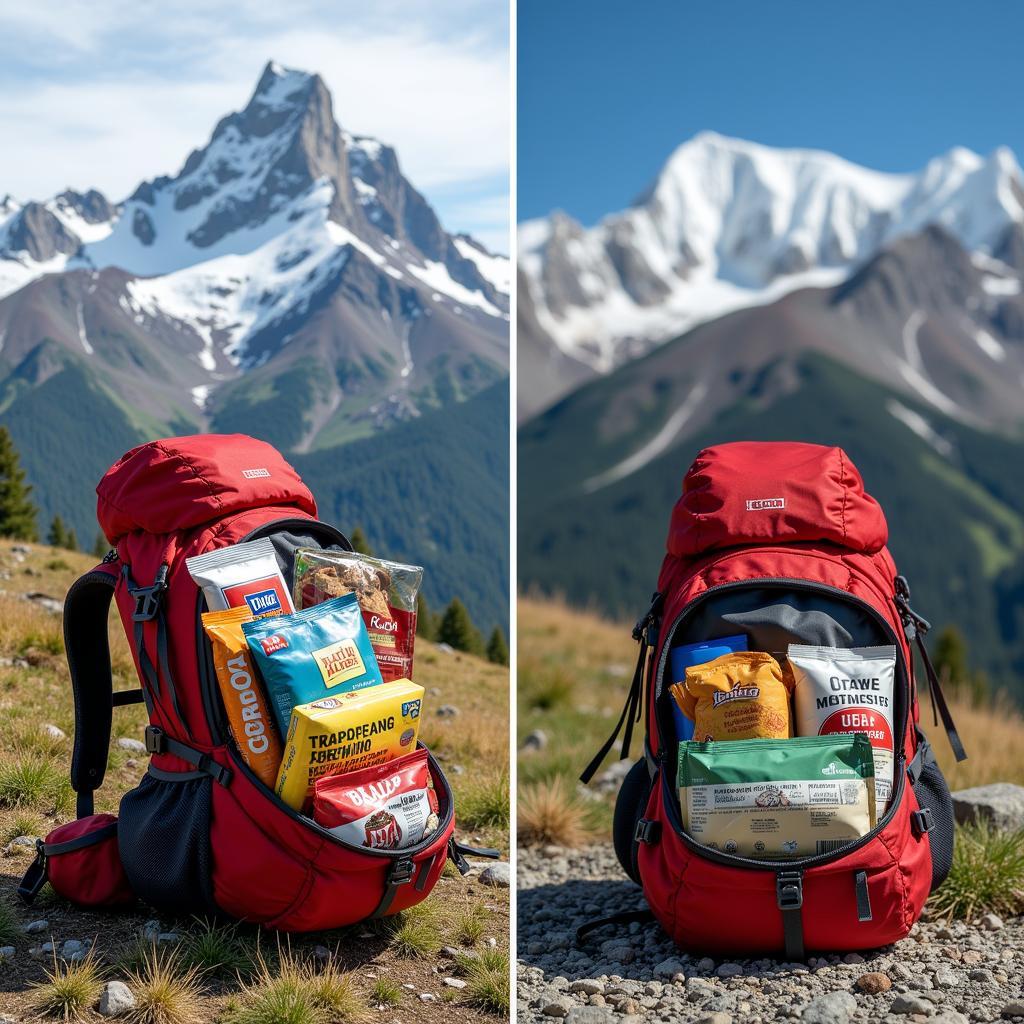Packing for a mountain adventure is about more than just breathtaking views and conquering trails; it’s about ensuring your safety in unpredictable environments. One crucial aspect often overlooked is packing adequate Mountain Emergency Food. Whether you’re facing unexpected delays, sudden weather changes, or an unfortunate mishap, having reliable sustenance can make all the difference.
But with countless options available, how do you choose the right mountain emergency food for your needs? Fear not, fellow adventurer, for this comprehensive guide will equip you with the knowledge to make informed decisions and pack your emergency stash like a seasoned mountaineer.
Factors to Consider When Choosing Mountain Emergency Food
Before diving into specific recommendations, let’s explore the key factors that should guide your selection process:
1. Calorie Density: In emergency situations, your body needs a concentrated energy source. Look for foods that provide a high calorie-to-weight ratio, ensuring you get the maximum energy boost from a minimal load in your backpack.
2. Shelf Life: Your emergency food might sit untouched for months, even years. Choose non-perishable or long-shelf-life options like dehydrated meals, energy bars with extended expiration dates, and dried fruits and nuts.
3. Nutritional Value: While calorie content is crucial, don’t overlook essential nutrients. Opt for foods that offer a balance of carbohydrates, protein, and healthy fats to support your energy levels and overall well-being.
4. Ease of Preparation: When hunger strikes in the wilderness, the last thing you want is a complicated cooking process. Prioritize foods that require minimal to no preparation, such as ready-to-eat meals, energy gels, or simply adding water to dehydrated options.
5. Taste and Palatability: Let’s face it; even in survival mode, no one wants to choke down unappetizing food. Choose options you genuinely enjoy to keep your morale high during challenging times.
6. Weight and Portability: Every ounce counts when you’re trekking through challenging terrain. Pack lightweight and compact food items that won’t weigh you down.
 Comparing Different Types of Emergency Food for Hiking
Comparing Different Types of Emergency Food for Hiking
Building Your Mountain Emergency Food Kit
Now that you understand the key considerations, let’s create a sample emergency food kit tailored for mountain adventures:
High-Calorie Essentials:
- Energy Bars: Packed with carbohydrates, protein, and often fortified with vitamins and minerals, energy bars offer a convenient and portable energy boost.
- Trail Mix: A customizable blend of nuts, seeds, dried fruits, and chocolate provides sustained energy and essential nutrients.
- Nut Butter: High in calories and healthy fats, single-serving nut butter packets are a great addition to your kit.
Dehydrated Meals:
- Backpacking Meals: Lightweight, compact, and requiring only boiling water, these meals offer a comforting and nutritionally balanced option for extended trips.
- Instant Oatmeal: A quick and easy breakfast option, instant oatmeal provides warmth and energy on chilly mornings.
Extras:
- Electrolyte Powder: Replenishing electrolytes lost through sweat is crucial, especially in high-altitude environments.
- Hard Candies: Offer a quick energy boost and can help alleviate nausea, a common ailment at higher elevations.
- Dried Fruits: A natural source of sugar for a quick energy boost and a tasty treat.
Tips for Packing and Storing
- Pack in Waterproof Containers: Protect your food from moisture and the elements by storing it in resealable plastic bags or waterproof containers.
- Label Clearly: Clearly label each item with its expiration date to ensure freshness.
- Rotate Your Stock: Regularly check the expiration dates of your emergency food and replace any expired items.
- Store in a Cool, Dry Place: Keep your emergency food kit in a cool, dry place away from direct sunlight to preserve its quality.
FAQs About Mountain Emergency Food
1. How much emergency food should I pack?
A general rule of thumb is to pack enough food for an additional day or two beyond your planned trip duration. However, consider factors like the remoteness of your route, weather conditions, and your personal needs.
2. Can I pack fresh fruits and vegetables?
While fresh produce can be tempting, it’s not ideal for emergency food kits due to its short shelf life and potential for spoilage. Stick to non-perishable options.
3. What about water?
Water is even more critical than food in survival situations. Always carry more water than you think you’ll need and consider packing a water filter or purification tablets.
4. Should I consider any dietary restrictions?
Absolutely! If you have any dietary restrictions or allergies, carefully read food labels and choose options that meet your needs.
5. Can I use my emergency food for regular snack breaks?
While it’s tempting, try to reserve your emergency food for true emergencies. Pack separate snacks for regular consumption.
Be Prepared, Stay Safe
Remember, preparation is key when venturing into the mountains. By carefully choosing and packing appropriate mountain emergency food, you’re equipping yourself with a crucial safety net.
Need help choosing the perfect gear for your next adventure? Contact us! We’re available 24/7 to answer all your questions.
Phone Number: 02437655121
Email: [email protected]
Address: 3PGH+8R9, ĐT70A, thôn Trung, Bắc Từ Liêm, Hà Nội, Việt Nam.